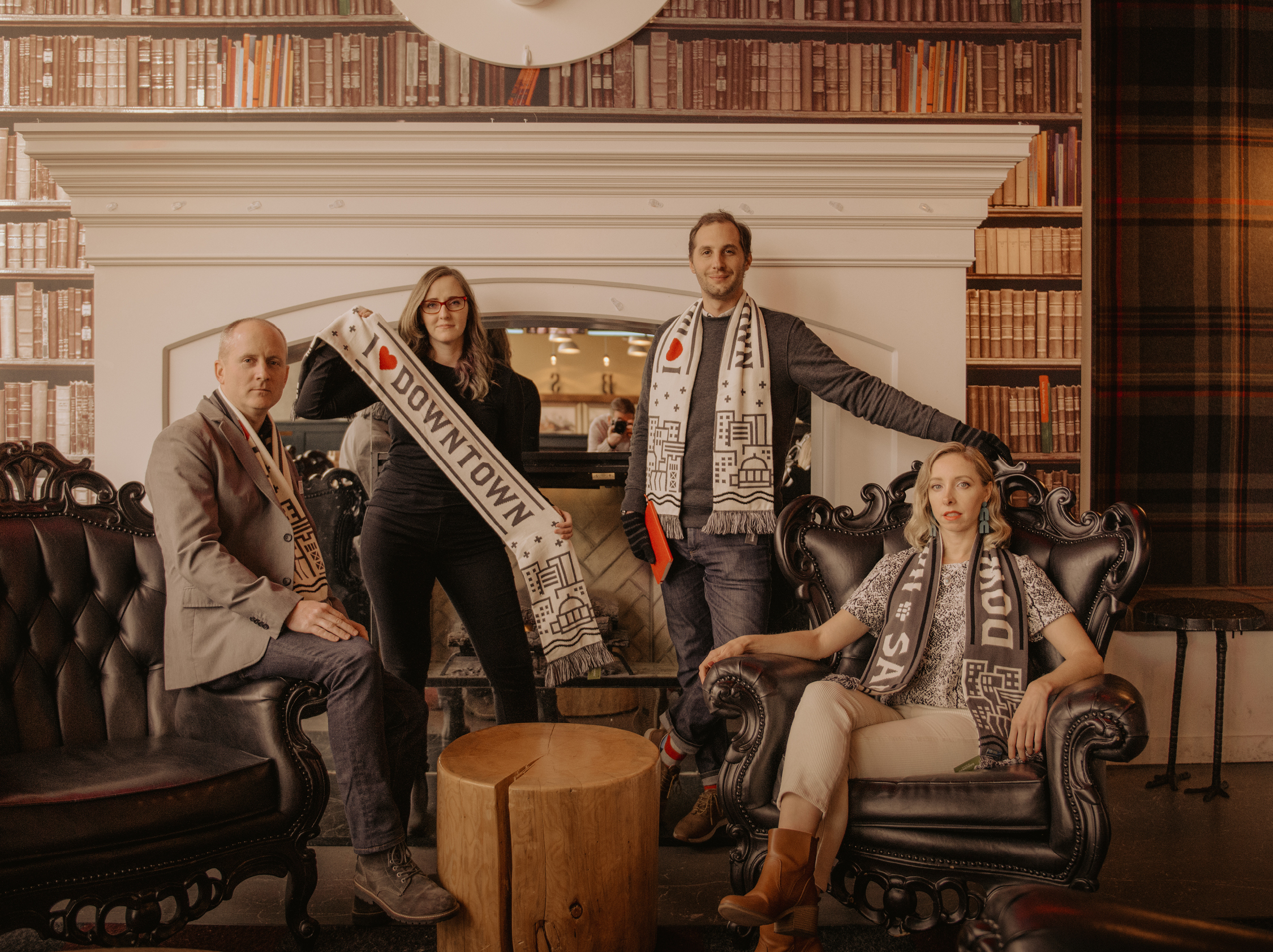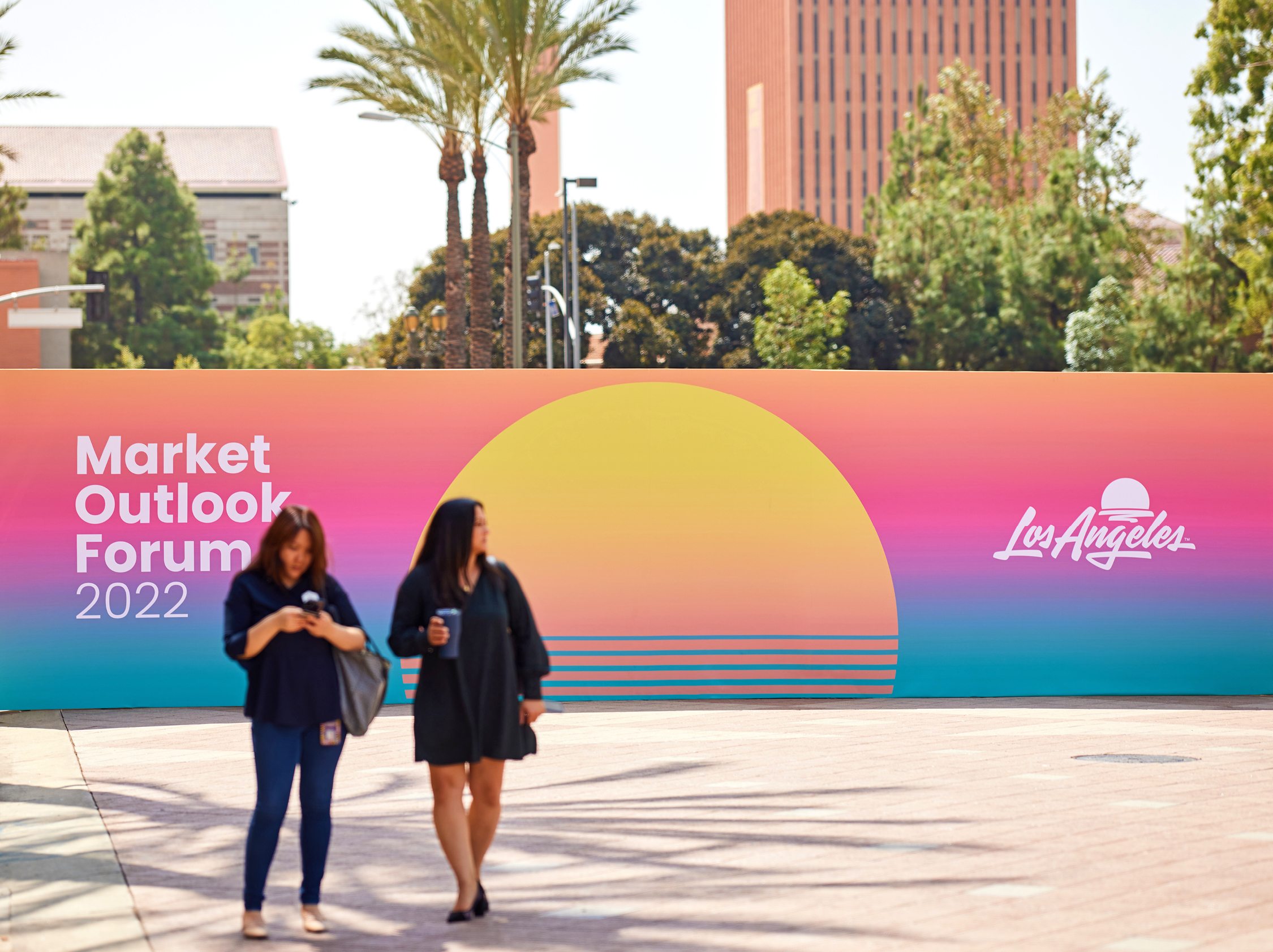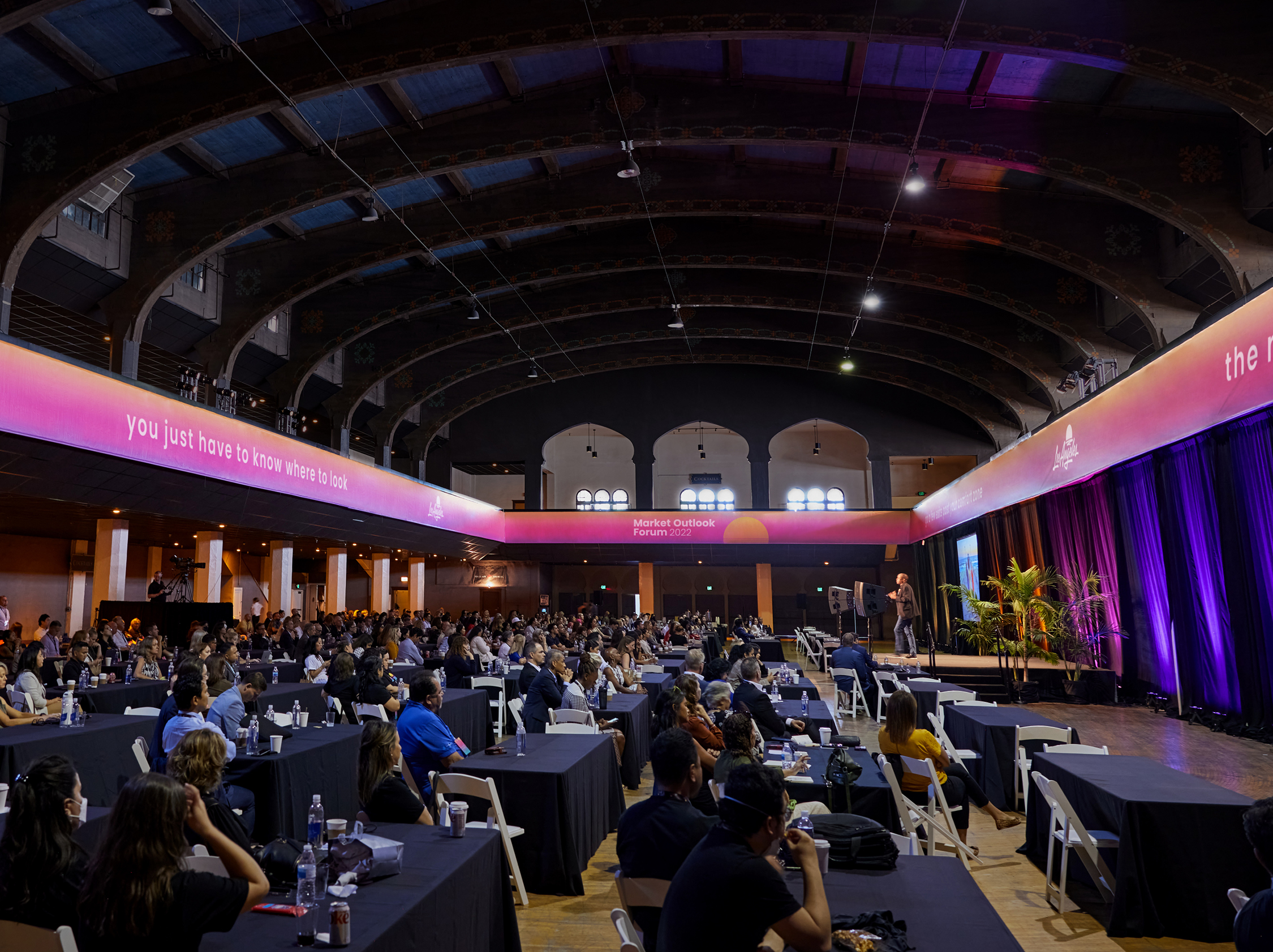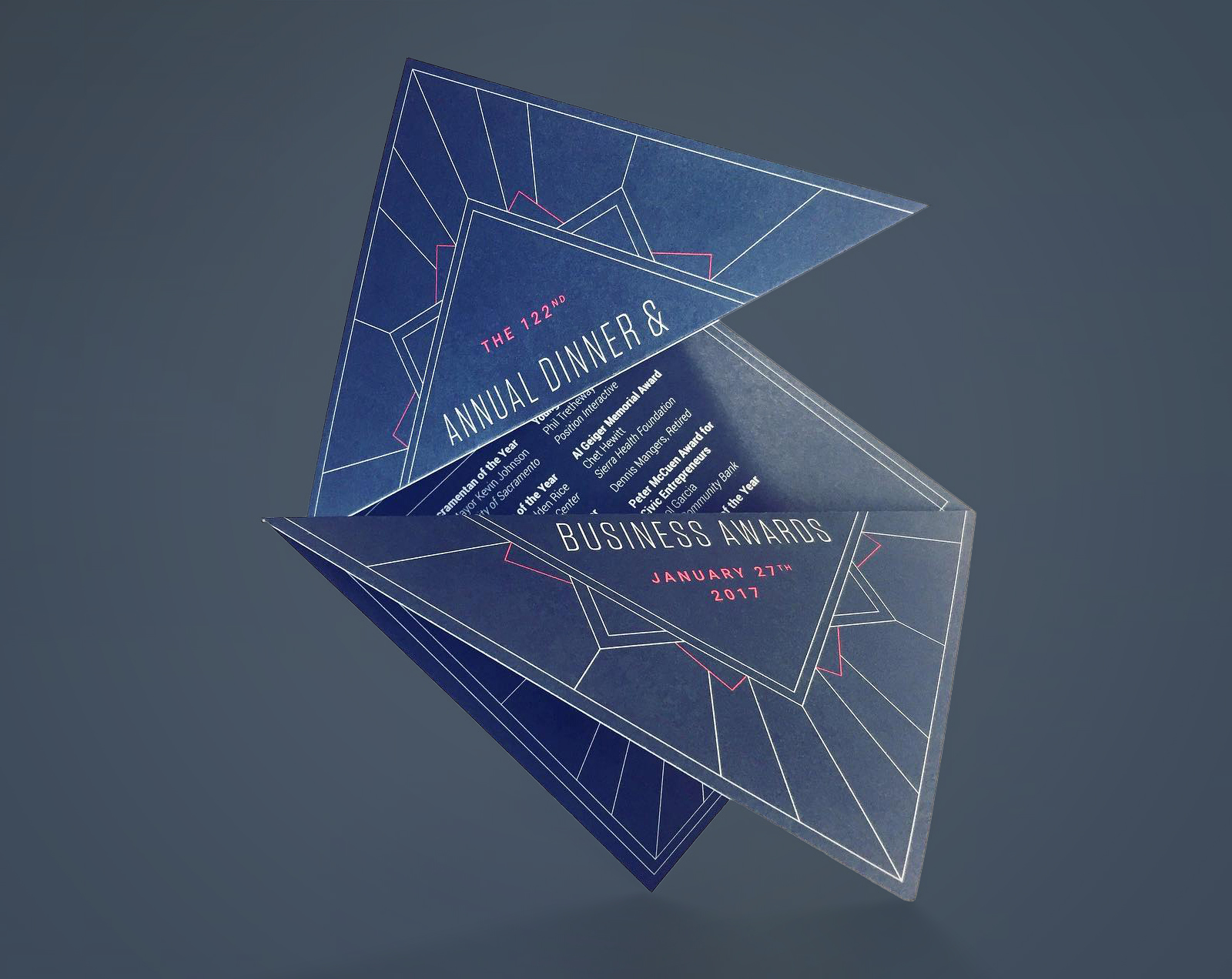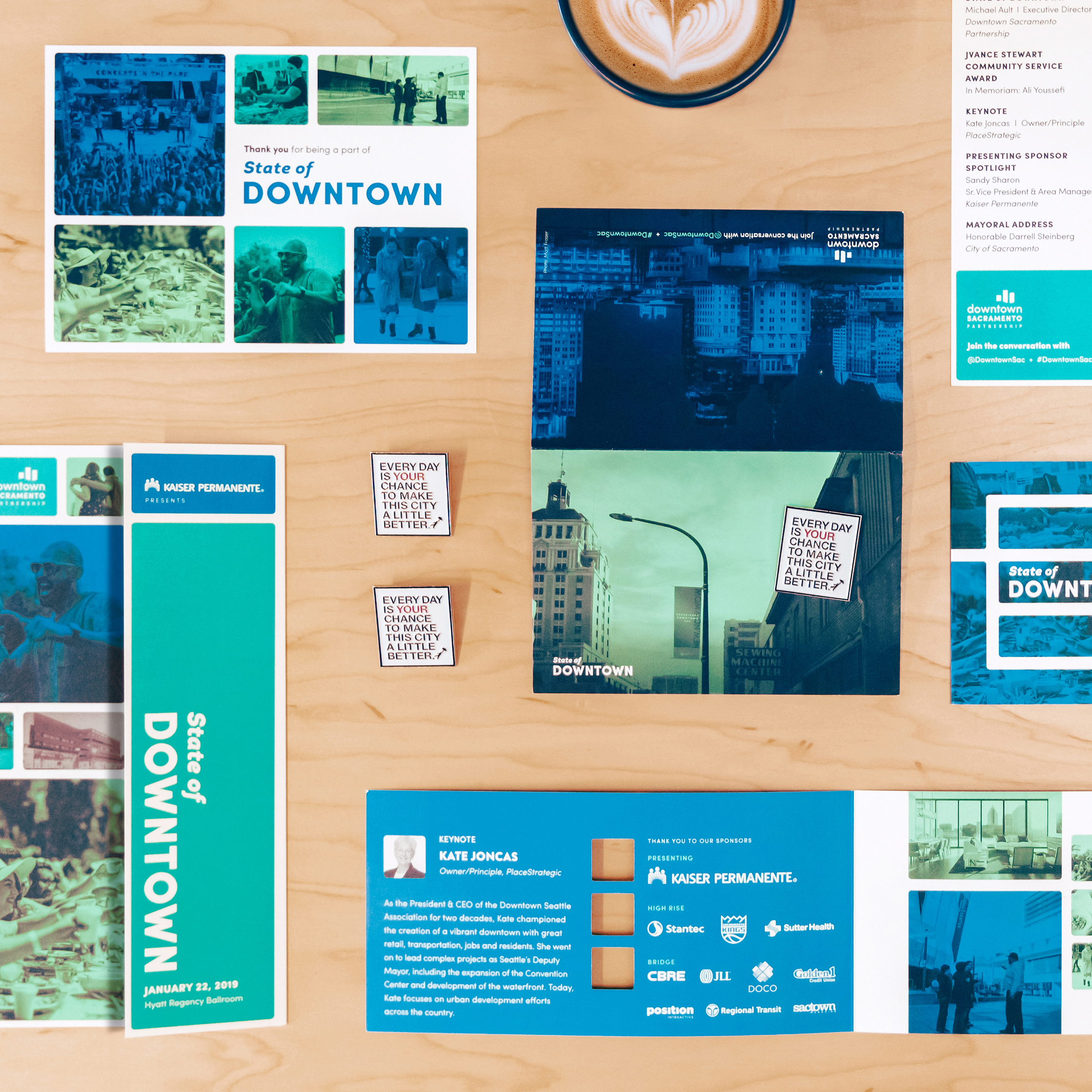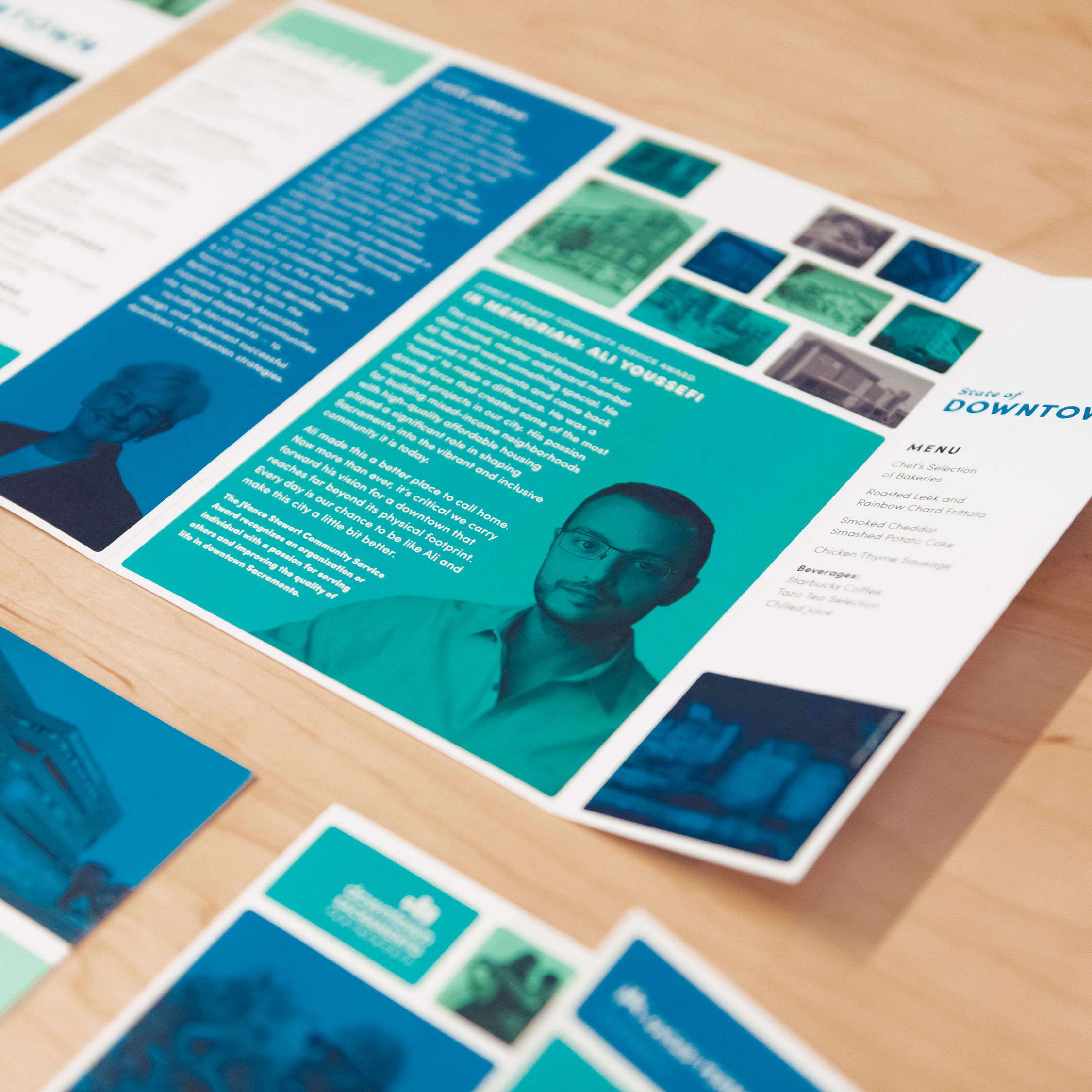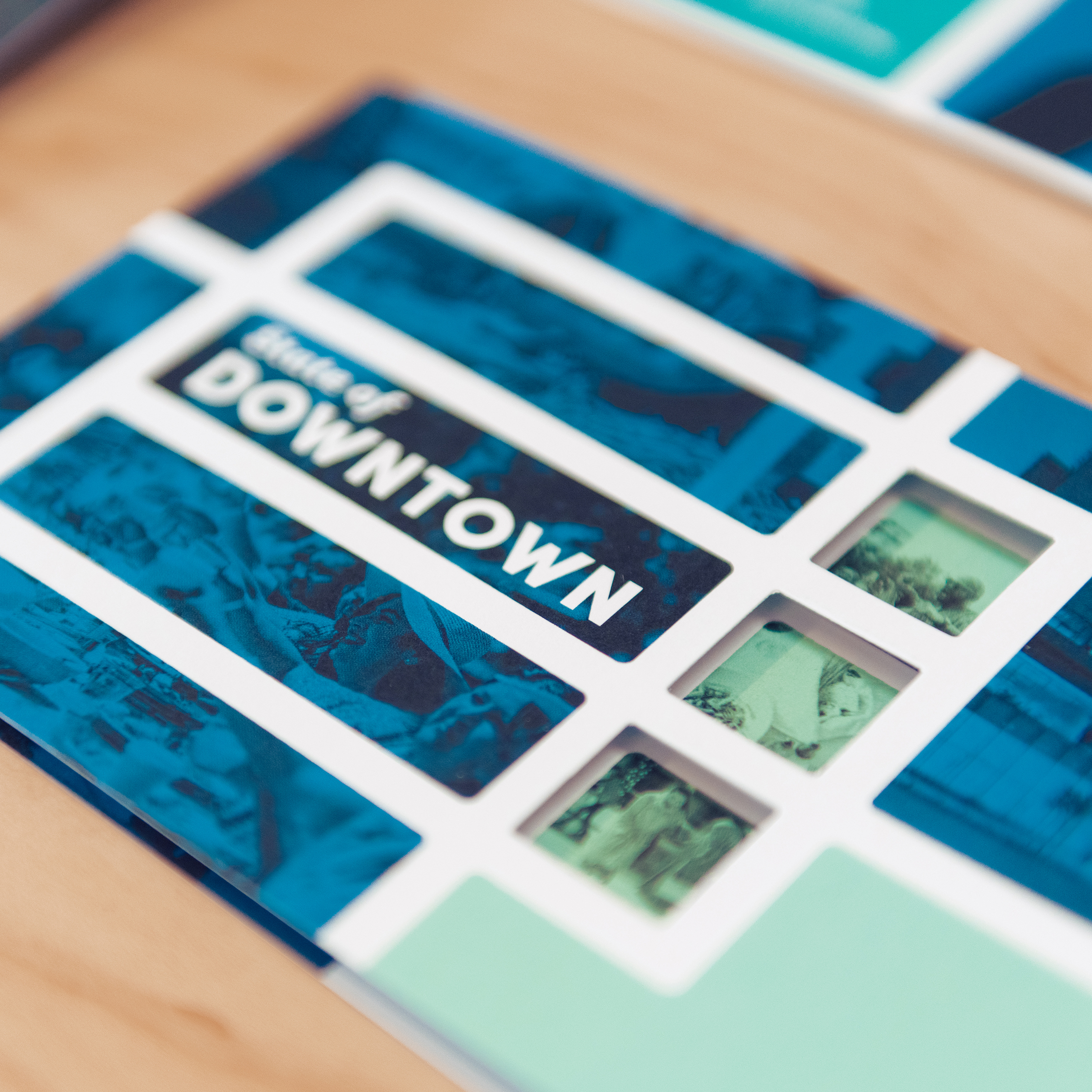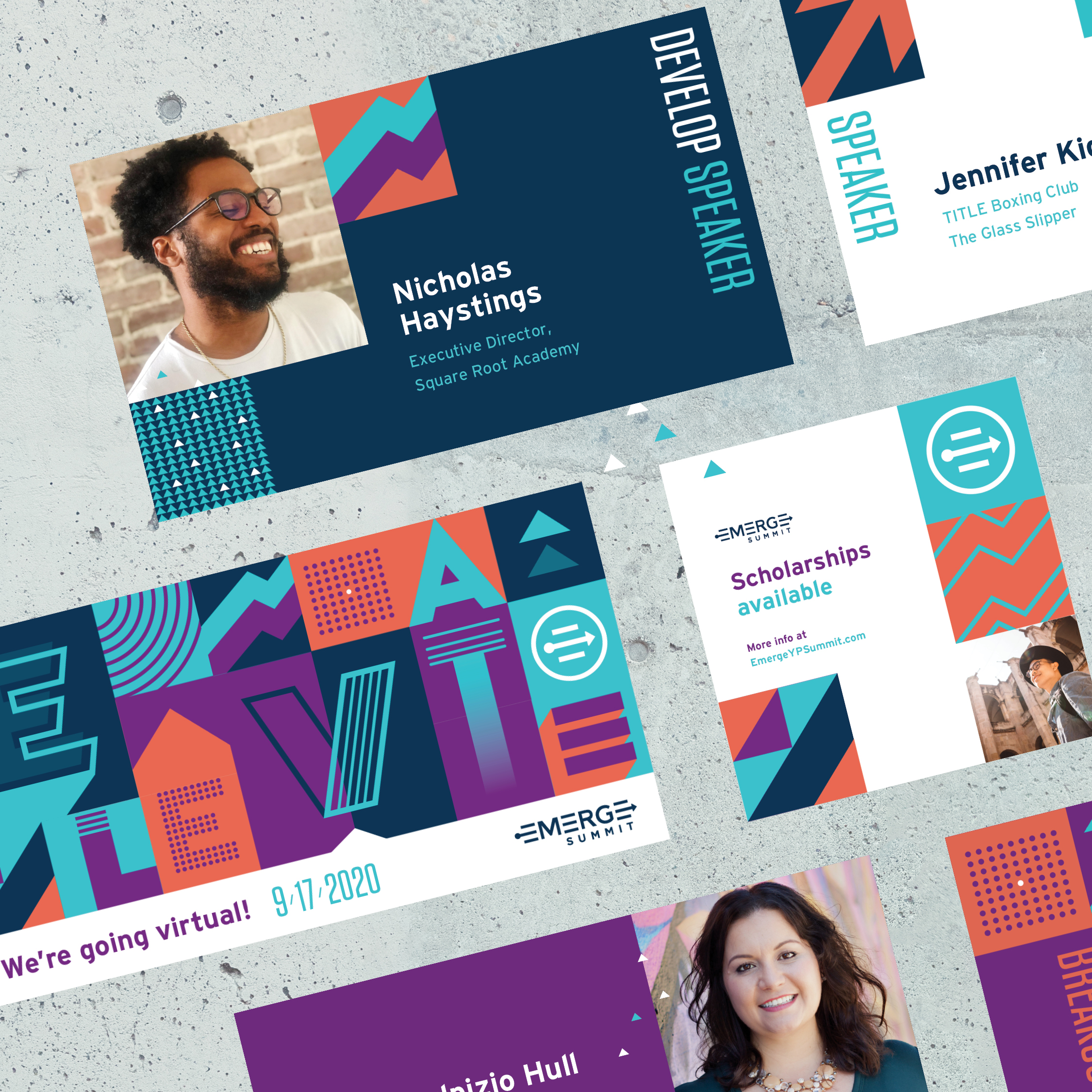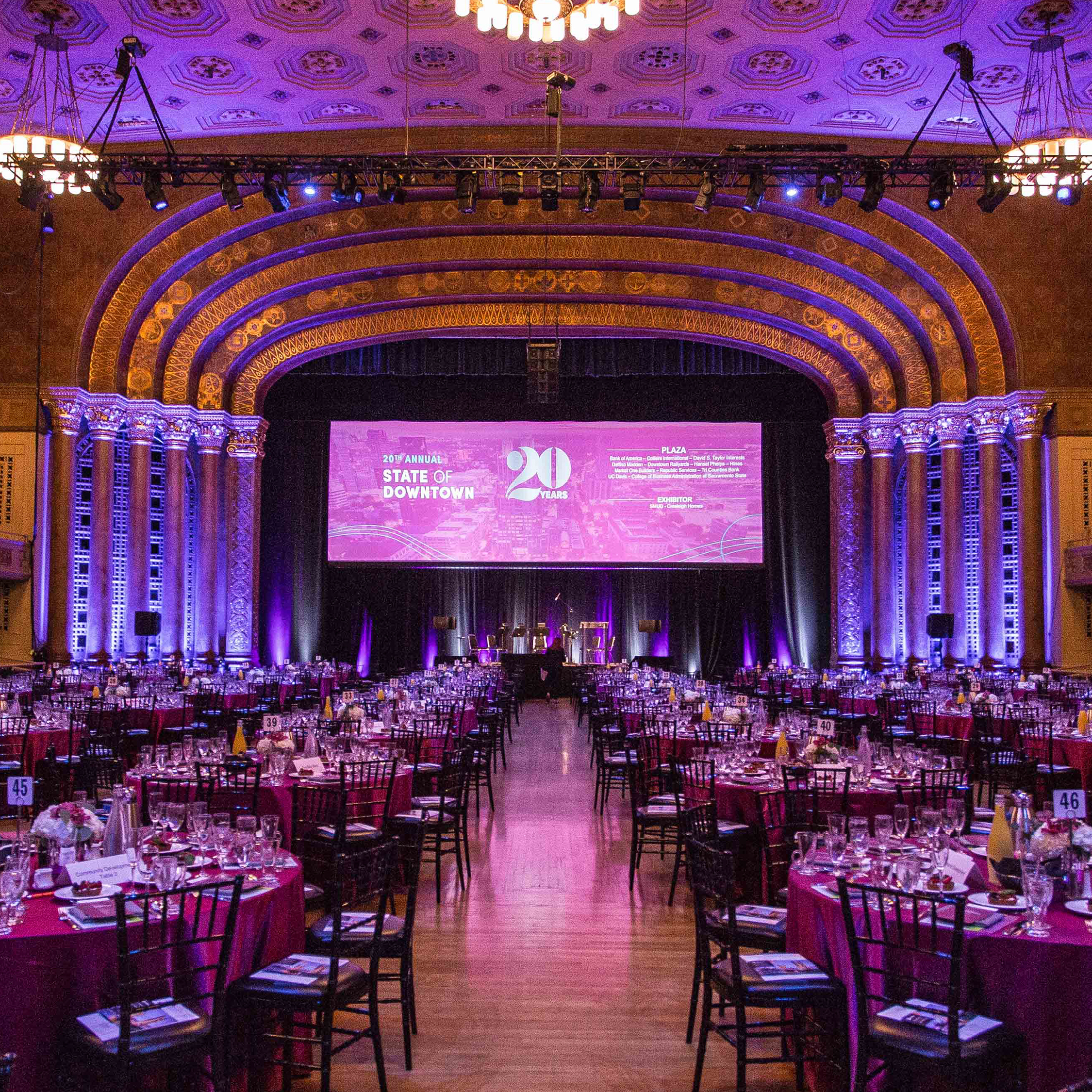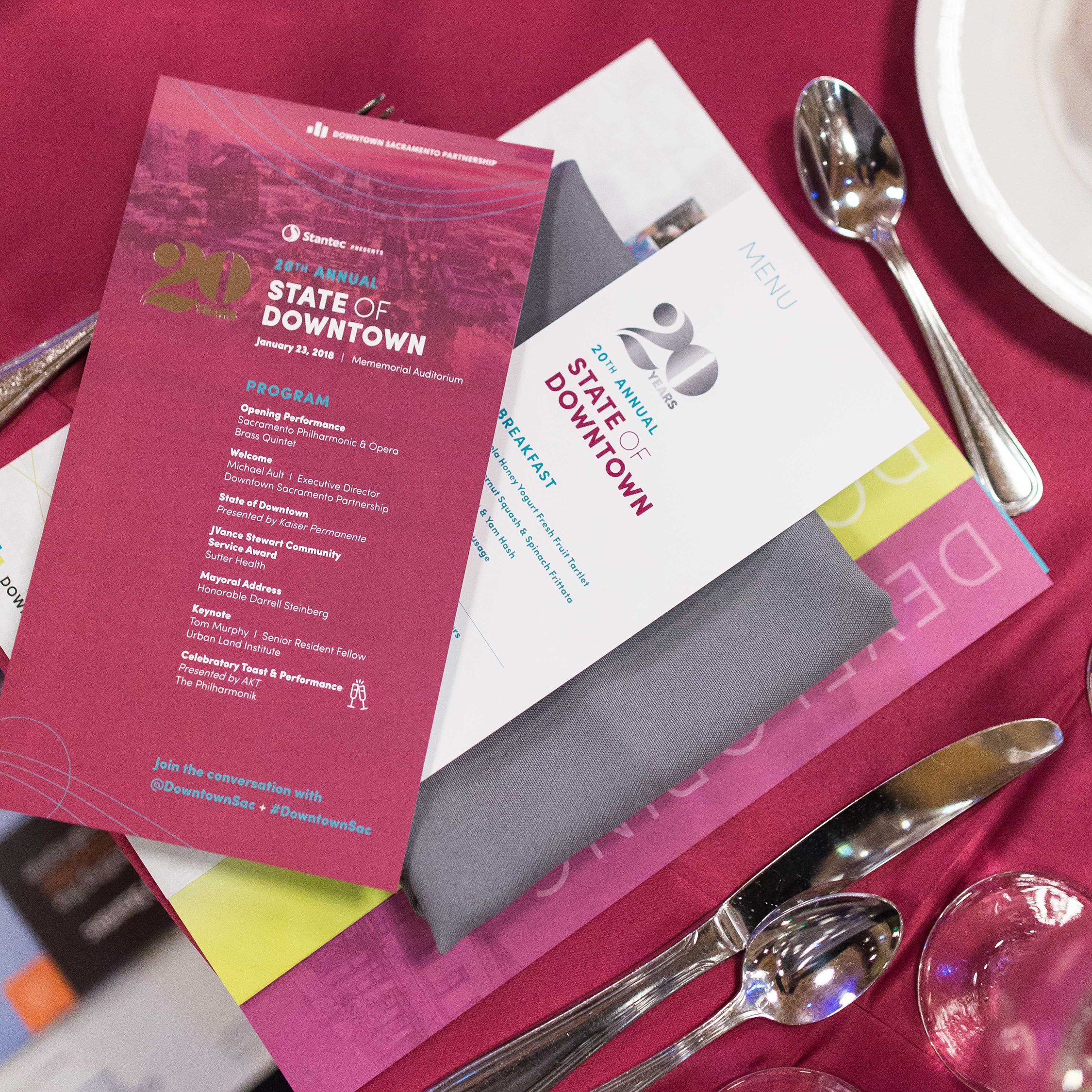4 Tips for a More Impactful, Modernized Association Event
Events are your most immediate tool for ensuring members remain connected, educated, and inspired. The future of your association depends on its ability to demonstrate value to members.
Whether your association will host a gala, conference, or convention in the coming year, you ultimately stand at a crossroads. Do you apply the same, tried-and-true approaches to frame this vital connection with your audience? Or would your association and its members be better served by a more contemporary approach?
1. Ditch the Printed Program for Your Conference or Convention
Printed programs have their place. For example, black-tie galas and awards dinners that are more formal experiences benefit from the more upscale tactile experience of a printed program or menu. But how many times have you walked around the ballroom after the first day of your conference to find countless programs left behind?
For a multi-day event, it’s more convenient to have a digital program. This option is easier for staff because last-minute changes can be made on the fly without the need to reprint anything. Plus, it’s convenient for the members because they can access the information at any time on their phone without having to carry around a printed program.
Today, smartphones are the most common source of information. Your members may forget your event program on a table — but they’ll never be without their phones.
Bonus idea: Place multiple phone charging stations around your conference. They’ll create “water cooler” moments amongst your members.
Event Apps and Websites Offer Flexibility and Functionality
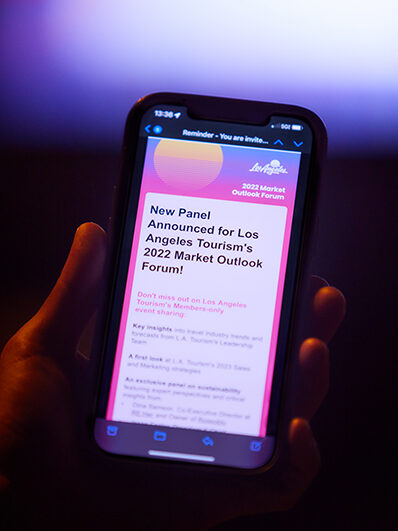
Annual conferences, summits, and conventions present ideal opportunities to replace printed programs with a digital app or website. Your stakeholders may worry about the missed opportunity to sell ads in your event’s program, but often these ads are grandfathered in as part of an antiquated sponsorship package with your association. By eliminating the printed program and therefore the printed ads, you gain alternative opportunities that often create more value for your sponsors and members.
Even if your board remains set on a printed program, you can minimize its footprint by combining it with a digital companion piece, where members can read complete speaker bios, program descriptions, or schedule updates. At one time, cryptic QR code badges looked like a joke. Now, their increased adoption enables these codes to provide an efficient way to guide members to more information.
2. In-Person Events Take Priority Over Virtual Alternatives
The pandemic forced every association to rethink its events. Now, with virtual conferences no longer the only option, organizations and their members are understandably excited to meet again in person.
Virtual events still offer benefits. They provide your association with a broader reach and a more accessible experience that also eliminates travel costs. But they require a lot of production to be successful.
If your organization is staging an in-person event, your team may struggle to present a virtual counterpart at the same time. Instead, consider the aspects of your program that you can offer virtually. For example, keynote addresses or high-profile presentations can be recorded and posted on your website for current and prospective members. Along with granting your event a second life, you build buzz for next year by teasing the value of your event.
3. Digital Signage Amplifies Your Event’s Message
At one time, foam core signs on easels provided the baseline for how your association greeted members at the event venue. Now, flatscreen monitors offer a cost-effective way to modernize your event with signage that’s colorful and flexible. Better still, they don’t wind up in the trash after your event closes.
Many event facilities offer a way for your association to rent large monitors, which you can place on stands around the venue. Through a Wi-Fi link, you can connect these TVs to a laptop and broadcast a branded PowerPoint deck that welcomes your attendees. As your event progresses, you can change what’s displayed on these monitors to reflect the latest updates.

Digital signage doesn’t just offer more flexibility to post schedule changes; they also allow you to draw a closer connection with members. For instance, if you have a mixer on night one, you can use these monitors to display photos from it on day two. Instead of seeing the same static logo, your members begin the next day with a vibrant display of upcoming programming and their fellow attendees having a good time. Plus, the monitors offer the possibility for an additional sponsorship opportunity by incorporating ads into your association’s visual content.
4. Mixing Things Up Is Crucial for Modernized Events
Part of the excitement that comes with staging your association’s event is the ability to change your approach. If you opt against printed programs, you free up your budget to make an impact elsewhere. Or, by rethinking your approach to a printed asset, you can create something different that makes an impression on current and future members. For example, money previously spent on programs could fund elegant, die-cut invitations that point to the caliber of your upcoming event. Or, you could rethink your program to incorporate a show-stopping asset that folds into a poster that elevates its value. After all, if you’re going to print something, you might as well leverage it into something special.
Your event space is another area rich with opportunities. Working with the right creative team, you can create attention-grabbing activations like large-scale wall graphics that allow you to own the space. Dynamic activations encourage members to interact and engage with your event and join the conversation on social media.
No matter your association’s industry, events offer a chance to connect with members in a way that’s inspiring and energizing. With a modernized approach, you can strengthen that connection in a way that reflects the past while looking toward the future.
Navigating the Minefield of Opinions to Get Effective Feedback
Whether your association needs a rebrand or a new website, your biggest challenge isn’t always finding the solution to the problem at hand. Instead, it’s clearing the hurdles of final approvals from your stakeholders.
Projects run more smoothly when every stakeholder is involved. That said, demanding schedules may prevent your leadership from attending every meeting. When presenting designs for their review, there’s no worse feeling than watching progress derailed by an ungrounded opinion.
Of course, website design is a mix of art and science. No one can predict with total certainty how users will respond to a site’s appearance or how it functions. However, for a successful project, any opinion guiding a design’s direction should be supported by strategy and facts rather than personal preferences. After circulating a project for feedback with your launch date on the line, it may be tempting to respond with “Take your left-field opinion and shove it.” Of course, you wouldn’t say that. Our goal today is to avoid experiencing that frustration.
But setting opinions aside doesn’t mean your organization can’t have a website you or your leadership team love. In fact, your preferences are essential — when the time is right. But to secure a design that works, you must put strategy first.

Opinions Lead Organizations Astray from Rebranding Goals
Taking a strategic approach to your project means the design is built on a foundation of research and proven data about your association and its members. Crafting a design based on your preferences or those of your board is a risky use of your budget. Personal opinions are not only subjective, they’re much more volatile.
Past experience or even someone’s mood that day can inform their preferences. For example, a client we worked with rejected a design option because the colors resembled the rival school where they went to college. These kinds of opinions have nothing to do with the problem you’re trying to solve for your brand.
No matter how much your CEO trusts their personal taste, you can’t allow those impulses to guide your project’s decisions. You’re working to create a tool that will strengthen your association’s bond with its current members while also appealing to the next generation. Designing to connect with those specific audiences requires more than opinions and gut feelings to be successful.
For example, even though your association is targeting Gen Z with a digital project, your stakeholder feedback comes from your board. Everyone on your leadership team is highly intelligent and well-intended, but their preferences may have little relevant connection with the experiences of a 30-something, digitally savvy, and diverse population. You must provide them with the right context for the project and its goals so they can deliver a thoughtful evaluation. Otherwise, they will naturally fall back on offering personal opinions.

Strategy Takes the Lead on Successful Redesign Projects
Every marketing and communications executive knows that most successful projects start by following a strategic framework. No matter whether you’re planning a single digital campaign or a full rebranding for your association, your project has to start with creating a strategy document. The key to success is ensuring this document is well-founded and utilized throughout the entire project, by your agency and your team.
A strategy document is a tool built during a project’s discovery process that creates a guide for every decision to follow. At the beginning, you and your agency partner should work together and define the challenges your project needs to solve and other key details.
If success is solely defined as creating a design that pleases your boss, then your project is in danger of starting on the wrong foot. You have to prioritize fulfilling your association’s objectives over satisfying one individual’s opinion.

Research Forms the Foundation of Any Strategy Document
Depending on the size of your project, you can apply multiple forms of research to create a strategy document. For example, site analytics data such as visitor traffic, session lengths, and user information allow you and your agency to build a baseline of quantitative data. As discovery moves forward, interviews with your internal teams and user surveys are among the ways to get qualitative insights.
In the end, your strategy document reveals at least three defining attributes of your project:
- Audience: Your target users and their needs.
- Messaging: How your association will communicate to its audience.
- Goals: What the project must accomplish for your association.
At key milestones, you and your decision-makers should reference the approved strategy document to resolve design questions. A solid strategy gives you the confidence and authority to push back on unfounded opinions, even when they come from people that outrank you.

3 Tips to Avoid Common Pitfalls of Project Decision-Making
You and your stakeholders will be providing feedback to your digital agency as your project takes shape. Avoid costly changes to your timeline (and your budget) by applying these 3 rules:
1. Depend on a Single Source of Truth
Whether your strategy document remains accessible on your internal network or framed on your wall, it should always be available for everyone on your team. It is the guiding light for your organization’s project. Consult the strategy document before every design review, so your internal teams are in the right mindset.
2. Apply Context to Every Decision When Delivering Feedback
If you ask your stakeholders for their opinion, you’ll get their opinion. Instead, request an analysis of your design while giving the right tools to make a decision. Instead of asking, “Which logo appeals to you?” frame the question a different way. Try asking, “Which logo will appeal to our audience and best communicate our message?”
3. Lean Into Your Experts
When your project needs feedback from your leadership team, you don’t have to go into those conversations alone. You should gather your creative team with your organization’s decision-makers in the same room for milestone decisions. That way, your design experts can communicate the rationale behind each option, ensure the conversation stays on track, and address questions that may potentially derail the project.

When Opinions Are Welcome (and Essential) in a Design Project
Placing your organization’s strategic goals ahead of personal preferences may be challenging, but it’s not a constant requirement. Once you’ve established that your project’s needs can be fulfilled with multiple design concepts, you should leverage your preferences to make a final choice.
After all, the right design partner wants you to be proud of the final product. Once your new website or campaign launches, you should love it and be excited, especially if it involves a total rebranding or visual identity.
Plus, when you have the assurance that every decision was made in service of solving the challenges at hand, your ability to act as your project’s champion grows much easier.
Follow These 4 Steps to Ensure Your Next Website Project Kicks Off Right
When your member-driven organization needs a new website, searching for a design and development partner feels like the hardest part. Finding an agency with the qualifications and capacity to meet your schedule takes time and research. However, once you’ve hired the right team, the rest is just a matter of sitting back and waiting for your new website to launch and work as it should.
Not so fast.
Successful websites can’t simply be ordered up and delivered like an Amazon package. Redesigns cost more than money. If you want a site that makes a real difference for your organization, you have to invest your time as well. Dedicating time to your project before it officially kicks off ensures your organization receives the full value of its investment.
You’ll see the best results when both sides of a website project are active participants. Get your collaboration started right by following these steps:

1. Set Aside Expectations and Look Past Prior Website Project History
Website development should start by taking a holistic view of your website’s audience, your organization’s goals, and its messaging strategy. A collaborative examination of those details allows your agency to push past status quo solutions and discover the right approach for your website.
Coming into a website project with rigid, preconceived ideas about what your site requires limits how well your project addresses your organization’s needs. Similarly, if you’ve had a bad experience during a prior website design, you should discuss the details behind that project with your new agency.
What derailed your previous website’s success? Was it internal? Was it external? What was most painful about the process for your team? The right agency will help you identify those roadblocks and come up with tactics to prevent the same issues from occurring.

2. Build a Dream Team of Internal Stakeholders
As head of a marketing or communications team, the website may fall under your jurisdiction. But you can’t manage a website project alone. You need a small but mighty group of 3 to 5 people on your side who will support this project as a key priority from start to finish.
However, you shouldn’t attempt to recruit every stakeholder in your organization. For example, your CEO may be invested in a new website, but a busy schedule may hamper their availability. But involving all stakeholders in your organization in the day-to-day of the project may shift focus toward concerns related to their roles instead of solving problems for your end users.
Instead, someone from your team can keep all your stakeholders informed as your website design progresses. Keeping everyone in the loop helps prevent the project from being derailed by last-minute changes by allowing key stakeholders to provide feedback throughout the process.
Ultimately, this dream team should have the ownership on approving deliverables and other milestone decisions to ensure the project moves forward. Therefore, thoughtfully curating this team is critical, and each should be experienced with your current website.
The most important member of your team is the liaison between your organization and the agency. They will be responsible for coordinating meetings and collecting internal feedback. Ideally the liaison would have support on the team from a project coordinator. This person will oversee details such as collecting images, website copy, and other deliverables to satisfy content deadlines.

3. Be Realistic About Timelines to Protect Your Project Launch Date
Every website project lives or dies based on how well it follows an established timeline. The agency you hire is obligated to deliver your website by a certain date. But your team is just as responsible for ensuring it will be available to attend meetings, provide deliverables, feedback, and approvals, so your project stays on track.
Given the value of your organization’s website, you may be in an understandable rush to relaunch with a new, more functional design. But you have to be realistic about your team’s availability as well as the impact of their other responsibilities.
Before your website project starts, you should carefully review the timeline and honestly share any concerns. Be sure to factor in the availability of your project team and internal stakeholders to ensure your new website remains on track.
For example, someone on your team may have a two-week vacation planned. Or, the deadline you set for all website content to be delivered coincides with your organization’s annual convention. Whatever big events, holidays, or busy periods lie ahead, those need to be factored into your timeline to protect your launch date.
As your organization’s point person, you are responsible for setting up the foundation to keep your team on schedule. For example, you can set up all internal review meetings at the onset of the project so you can ensure availability of your team for all review points throughout the project. The right agency partner will do their part stay on track, but they can only do so much without your help.

4. Do Your Homework Before Any Redesign Work Begins
As a marketer, you know your organization’s website needs improvement. But how well do you really understand the full breadth of its condition?
You don’t have to diagnose your site’s needs — your agency partner will help you with that. But you should take the time to inventory all of your content and understand its purpose, accuracy, and context.
Maybe your organization’s last redesign was five years ago, or it took place before you were hired. But in either case, large websites often have legacy features that no longer apply to the organization’s current goals. Or, worse yet, function in a way no one understands.
Before you and your agency start rebuilding your site, you should ensure all those mysteries are solved. For example, contact your IT team to explain third-party tools or software tied to your current site and understand how they’re utilized.
Plus, you should meet with stakeholders to discuss new features on your organization’s wish list. Websites are challenging enough to develop without your team overextending its timeline and budget to create unnecessary features. But be sure to set expectations ahead of time that all new features will need to be in service of the website goals.
Before any functionality is built or designed, you and your agency partner should understand its purpose and the need it will resolve. By thoroughly understanding your organization’s problems, you and your agency can work together to design the right solution.
Why Your Association Can’t Overlook Email
Email is far from a fresh idea in communications, which may be why it’s often overlooked. A few years ago, industry watchers were ready to declare the communication channel dead as new messaging platforms arrived.
Now, the explosion of agencies that specialize in email strategy testify to its ongoing value. But in addition to considering what information your organization needs to send and how often, you need to also think about your emails from a design perspective.
An association with decades of history could spend thousands of dollars to create a modern website to present an up-to-date reflection of its identity. But their email communications remain stuck firmly in the past. Instead of driving traffic to your website, your email gets lost in the noise of each member’s inbox.
Any brand ecosystem needs to deliver a cohesive experience to be effective. Email provides an opportunity to create literal links between your members and your website. With the right approach to design, you can ensure your organization is making the most of those connections.
Email Offers Targeted Outreach to Rival Social and Traditional Media
Email doesn’t have the same buzzworthy appeal as social media platforms like LinkedIn, Instagram, or Tiktok. With millions of potential viewers, each channel offers the tantalizing prospect of your message going viral with the right mix of keywords and timing.
But realistically, social media requires time, effort, and energy to make a dent with the audience you need. You need to dedicate resources to monitor each channel, and it’s increasingly difficult to gain traction within the algorithm without a large budget. Much like traditional media, the return on investment can be uneven depending on the campaign and your audience.
Email by contrast is much more targeted. Members and prospective members have confirmed their interest by opting in to receive your information. Your organization can’t waste a valuable opportunity to deliver targeted messages to the audience it needs most.
3 Best Practices for More Impactful Emails
The visual experience of your email needs to be consistent with the rest of your brand. Even if you follow general email best practices for how the copy appears in each message, you need to ask whether your message conforms to the same rules as your website, your printed collateral, and any other touchpoints with your brand.
Are your emails curated to deliver valuable insights to current and prospective members? Do the visuals consistently reflect your brand identity? Is the tone aligned with the rest of your content? Are they adding to the rich narrative of your brand? The more cohesive an experience your organization delivers, the more likely your message is to stand out amid a cluttered inbox.
To underscore their value, your emails should meet the following 3 best practices:
1. Adhere to Brand Guidelines
Every email you send should reinforce your organization’s brand. The copy should reflect the same voice and tone used by your organization and visual elements should be consistent with your brand identity.
2. Be Focused with Your Content
Emails should be simple, direct, and relevant to the recipient’s interests. Your members will lose interest and unsubscribe if your message is cluttered with too much content, not relevant to their needs, or filled with ads.
Your distribution list targets an audience who is interested in your association. But you’re competing with each personal and marketing email they receive every day. Concise, targeted, and timely communication will allow your message to cut through the noise.
3. Encourage (and Monitor) Action from Readers
Emails are a powerful platform to deliver updates to your members, but it’s not the place to tell the full story. Emails need an image, a headline, and a brief teaser describing the content you’re promoting — and that’s all. If your members are interested, they will click the link to your site and find out more.
Emails are a powerful tool to drive visitors to your site, but they also inform your content strategy. You have to ensure your organization tracks user behavior on your site and in your emails to determine what is attracting readers. Once you know your audience’s interests, you can adjust your strategy to keep providing relevant content.
Emails Create Excitement for Your Organization’s Programs
Email provides a key point of contact between your association and its members at times when your information is most vital. For example, associations rely on successful annual events to engage members and encourage retention. Elevated event branding is an extension of your brand identity and email provides an effective way to promote your organization’s events to the right audience.
The most successful email programs deliver on the brand promise of the program and empathize with your members at each stage of their journey. For example, when communicating around an event:
- Advance emails (Save the Date, Invitations, Announcements) need to reflect the tone of the event and ramp up member excitement.
- During the event, provide support and value with a segmented attendee email with that day’s agenda and details.
- Don’t forget people who did not attend the event. Share emails outlining highlights and event photos to generate FOMO, driving attendance for the next event.
- Last but never least, collect feedback with an email survey of attendees to inform your strategy going forward.
In each case, emails allow you to showcase the value of your organization as well as its activities. But you can only demonstrate those details with the benefit of thoughtful design.
Clear, concise emails that express a strong visual connection to who you are as an organization underscore that your emails — and your subscribers’ time — are valuable. Don’t allow these critical points of connection to deliver anything less than a positive impression to your members.
How Event Branding Boosts Attendance, Sponsorship Dollars — and Your Organization’s Profile
As you approach the deadlines for your organization’s annual event, the pressure only grows. After all, no matter whether you’re set to stage a gala, fundraiser, or convention for members, the gathering provides a crucial connection with your most valuable audience.
If you host events for your members, you know attendance and sponsorship numbers from those events have a significant effect on your bottom line. Each event presents an opportunity to energize or even expand membership and increase revenue. To unlock your event’s real potential, you need to incorporate clear, consistent branding and an elevated design.
Events present a chance to create a physical extension of who you are as a brand. When executed properly, event branding delivers an experience that engages members while elevating the value and perception of your organization.
What Do We Mean by Elevated Event Branding and Design?
Branding your event requires more than a color scheme and clever theme. Any association can create collateral pulled from a few standard design templates and hope for the best. But how do you take an event to the next level?
Put simply: you create an event experience that’s smart and elevated. When we say smart, what we mean is that your event’s design is inspired by strategic decisions rather than arbitrary preferences. Each detail and design element you choose to incorporate into your event should be there because it reinforces the goals of your organization.
However, an elevated event experience doesn’t only communicate all the right things to embody your brand’s position. It can also inspire your members with a cohesive visual presentation and create a positive connection with your brand.
Think of what happens when you dine at a high-end restaurant. From the moment you check in with the host all the way up through dessert, your experience has been curated to communicate a message about where you are. Your event should provide the same elevated, consistent experience for your members.
Successful Events Rely on a Unified Purpose and Vision
From the earliest stages of marketing to the moment members leave the venue, the most successful events deliver an experience consistent with their brand. They are planned around a distinct set of goals. Every element of the event reflects a unified narrative and central purpose that serves the organization.
For example, if one of the goals of your event is to encourage renewals, then a well-branded event provides an opportunity to boost enthusiasm for members. If they feel energized and engaged by an event that’s elevated, cohesive, and exceeds expectations, they’re more likely to attend more events. And event attendance is a key element of member retention.
Any event is a two-part experience: The pre-event marketing and the in-person experience. Months beforehand, your communications should set the tone by providing a consistent journey from the save-the-date announcement through ongoing marketing. At the event each interaction with your members is a moment that adds to or detracts from the overall experience.
A successfully branded event comes down to bringing three elements into alignment:
- Quality of production: Is everyone on the team, from AV to the event planner, working together to maximize the attendee experience around the same goals? In our experience, collaboration and synergy can quickly take an event from good to great.
- Quality of content: Is your program and its messaging consistent with the event’s purpose and your organization’s goals? Relevant and valuable content is the backbone of a successful event.
- The marketing and visual experience: Is every visual element leading up to and during your event communicating a clear message that’s right for your brand? Up until they walk in the door, this is all attendees and sponsors have to judge your event by.
At Position, we align each of the elements above by collaborating with your team and event planners to ensure all aspects of your conference or gala reinforce your brand’s story. By shaping all the details into a cohesive whole, your organization delivers a more engaging experience for the audience who matters most.
Successful Event Branding Is an Extension of Your Organization
Organizations like yours host events for a number of reasons. Bringing your members together can provide real educational or inspirational value, convert attendees to members, and increase revenue through additional sponsorship. With the help of the right partners, your events can become game-changing assets for your organization.
When Associated General Contractors of California wanted to breathe new life into their organization and events, we helped them evolve their 100 year old brand and reimagine their industry conference. With AGC’s new strategic branding in place for its events, the organization increased attendance for CONSTRUCT 2021 by 31% and sponsorships for their Gala by 300%.
Your ability to deliver an experience that serves your organization’s goals is a complicated, high-stakes undertaking. You shouldn’t have to navigate all the details on your own.
How to Know Your Event Needs a More Thoughtful Approach to Branding
A conference that acts as an extension of your brand reinforces the value of belonging to your organization. The equity you gain from a successful event constitutes something of a loop.
The more engaging experience your members have, the more likely they are to attend the following year and renew their membership. As member attendance and engagement grows, so do sponsorship dollars.
Your event branding should add to the overall perception of your brand among your members and in the marketplace. But knowing whether the time is right to take your event to the next level depends on your organization. If attendance has been lagging, sponsorships have been flat, or you want to unlock untapped potential, it’s time to create a more engaging experience that’s aligned with your brand. If you’re ready to create a flagship event for your organization, we should talk.



